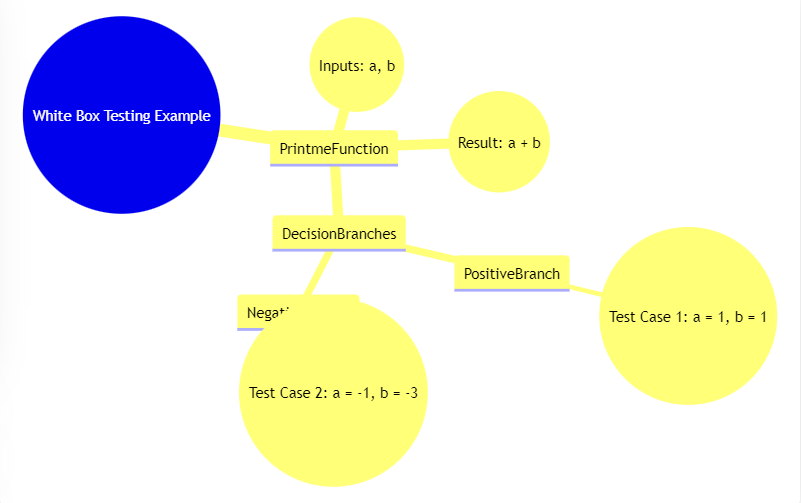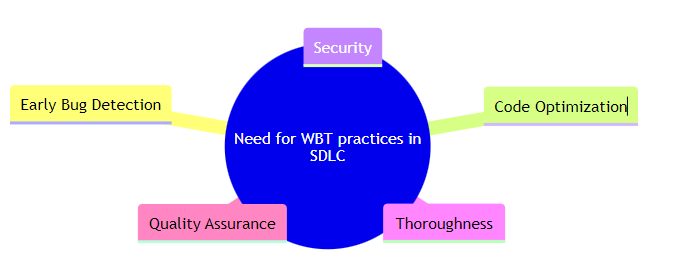What is White Box Testing? (Example, Types, & Techniques)
By Hamid Akhtar, Community Contributor - July 17, 2023
Imagine you’re an electrician tasked with checking the wiring in a house. White Box Testing is like having the complete blueprint of the house, including all the hidden electrical circuits, outlets, switches, and even the color coding of the wires. You’re not just checking if the lights turn on when you flip the switch (that would be more like Black Box Testing), but you’re examining the actual wiring behind the walls.
You’re testing the flow of electricity, the safety of the connections, and whether the right wires are connected to the right switches and outlets.
What is White Box Testing?
White Box Testing, or structural, code-based, or glass box testing, is a software testing technique that focuses on the software’s internal logic, structure, and coding. It provides testers with complete application knowledge, including access to source code and design documents, enabling them to inspect and verify the software’s inner workings, infrastructure, and integrations.
Test cases are designed using an internal system perspective, and the methodology assumes explicit knowledge of the software’s internal structure and implementation details. This in-depth visibility allows White Box Testing to identify issues that may be invisible to other testing methods.
- In the context of software, the “house” is the application, the “blueprint” is the source code, and the “electrical circuits” are the internal workings of the software.
- The “electrician” is the tester who uses their knowledge of the software’s internal structure to test its functionality, identify bugs, and ensure it works as expected.
Purpose and Benefits
White Box Testing serves a crucial role in software testing by allowing testers to inspect and verify the inner workings of a software system, including its code, infrastructure, and integrations.
The key benefits of White Box Testing include:
- Thoroughness: It provides complete code coverage, ensuring every part of the software’s internal structure is tested.
- Automation: Test cases can be easily automated, saving time and resources.
- Optimization: It helps in code optimization by identifying hidden errors and redundancies.
- Introspection: It provides an in-depth understanding of the software, which can be invaluable for future development and maintenance.
Comparison with other Testing Types
White Box Testing is often compared with Black Box Testing and Grey Box Testing:
- Black Box Testing: While Black Box Testing focuses on the software’s functionality without any knowledge of the internal workings, White Box Testing involves thoroughly examining the internal logic and structure of the code. Black Box Testing is less exhaustive and provides low-granularity reports, whereas White Box Testing is more comprehensive and provides high-granularity reports.
- Grey Box Testing: This combines Black Box and White Box Testing. While it involves some knowledge of the internal workings of the software, it is not as in-depth as White Box Testing.
In summary, White Box Testing is a more exhaustive and detailed testing method that provides a deep understanding of the software’s internal structure, making it a vital part of the software testing process.
Difference Between White-Box and Black-Box Testing
Imagine you’re buying a car.
- Black-Box Testing is like a test drive. You don’t need to know how the engine works, how the brakes are connected, or how the transmission shifts gears. You’re only interested in whether the car starts when you turn the key, moves when you press the accelerator, stops when you hit the brakes, and if the air conditioning and radio work. You’re testing the functionality without knowing the internal workings.
- White-Box Testing is like the inspection done by a mechanic. The mechanic lifts the car, checks the engine, examines the brake system, looks at the transmission, etc. They deeply understand the car’s workings and use this knowledge to check the internal components. They’re interested in more than just whether the car works, but how it works.
In software testing, Black-Box Testing is like the test drive (testing the functionality), and White-Box Testing is like the mechanic’s inspection (testing the internal workings). Both are important for ensuring high-quality, reliable software (or car!).
Types of White Box Testing
- Unit Testing: Imagine you’re building a bicycle. Unit testing would be like checking each part separately – testing the brakes, the gears, the pedals, etc., to ensure they all work correctly before assembling the whole bicycle.
- Static Analysis: This is like proofreading a book before it’s published. You’re looking for errors in grammar, punctuation, and sentence structure. Still, you need to read the book as a whole to understand the story (which would be more like dynamic analysis).
- Dynamic Analysis: This would be like test-driving a car. You’re not just looking at the components (like in static analysis), but you’re driving the car to see how it performs on the road.
- Statement Coverage: Imagine you’re a teacher checking a student’s homework. Statement coverage would be like ensuring the student has answered every question on the assignment.
- Branch Testing: This is like exploring all possible routes on a GPS. If you’re at an intersection, branch testing involves going straight, turning left, and turning right to ensure all paths lead to valid destinations.
- Path Testing: This would be like a postman ensuring they can deliver mail to every house on their route. They need to make sure every possible path is covered.
- Loop Testing: This is like checking a playlist on repeat. You want to ensure it loops back to the first song correctly after the last song finishes.
White Box Testing Example
def Printme(a, b):
result = a + b
if result > 0:
print(“Positive”, result)
else:
print(“Negative”, result)
In this code, Printme is a function that takes two inputs, adds them, and checks whether the result is positive or negative. If the result is positive, it prints “Positive”. If the result is not positive (i.e., zero or negative), it prints “Negative” along with it.
The goal of White Box Testing here is to verify all the decision branches (the if-else condition) in the code.
To exercise the statements in this code, we would create the following test cases:
- Test Case 1: a = 1, b = 1
- This would test the “Positive” branch of the if-else condition.
- Test Case 2: a = -1, b = -3
- This would test the “Negative” branch of the if-else condition.
By running these test cases, we can ensure that both branches of the if-else condition in the code are tested, which is the goal of White Box Testing.
Illustaration: Imagine this code as a road with a fork, where you can either go left or right. The decision to go left or right is based on whether the result is positive.
The result is positive in the first test case, so we go left (the “Positive” branch). The result is not positive in the second test case, so we go right (the “Negative” branch). By running both test cases, we ensure that we have traveled both possible paths at the fork in the road, which is the goal of White Box Testing.
What to Verify in White Box Testing?
In White Box Testing, you’re like a book reviewer who must check every chapter.
Here’s what you need to verify in white box testing:
- Code Paths: This is like checking every chapter in the book. You must ensure every part of the code is visited and works correctly.
- Loops: This is like checking if the book has any repeated chapters. In code, loops are parts that can run multiple times. You must ensure these loops work correctly and don’t repeat forever.
- Conditions: This is like checking if the book has twists and turns. In code, conditions can change what the software does. You need to ensure that every possible outcome of these conditions is tested.
- Inputs and Outputs: This is like checking the start and end of the book. You need to ensure that for every input (start), the software produces the correct output (end).
- Individual Parts: This is like checking every character in the book. In code, these are the individual functions or objects. You need to make sure each one works correctly on its own.
Remember, White Box Testing aims to ensure every part of the code works correctly, just like a book reviewer wants to ensure every part of the book makes sense.
Advantages and Limitations of White Box Testing
Just like a book review can help you decide whether to read a book, White Box Testing has advantages and limitations that can help you decide when to use it.
| Advantages | Limitations |
| Thorough Testing: Like reading every chapter of a book, White Box Testing checks every part of the code, making it very thorough. | Complexity: Just like a book can be hard to understand if it’s written in a difficult language, White Box Testing can be complex because it requires understanding the code. |
| Early Bug Detection: Like spotting a typo in the first few pages of a book, White Box Testing can find bugs early in the development process, which makes them cheaper and easier to fix. | Time-Consuming: Just like reading a long book can take a lot of time, White Box Testing can be time-consuming because it’s so thorough. |
| Improves Security: Like a book review that warns about inappropriate content, White Box Testing can find security issues in the code, helping to make the software more secure. | Requires Expertise: Just like understanding a book written in an old or foreign language requires special knowledge, White Box Testing requires a deep understanding of coding and implementation. |
| Optimizes Code: Like a book review that suggests removing unnecessary chapters, White Box Testing can find unnecessary or redundant code, helping to make the software more efficient. | Bias: Just like a book reviewer might miss flaws in a book they love, developers who test their own code might miss bugs because they’re too familiar with it. |
Remember, just like a book review is only one tool to help you choose a book, White Box Testing is only one tool to help ensure software quality. It’s most effective when used in combination with other testing methods.
Also Read: Whose Responsibility is Quality Management?
Techniques for White Box Testing
- Statement Coverage: This is like making sure you read every sentence in a book. In code, it means ensuring every line or statement of the code is executed at least once during testing.
- Branch Coverage: This is like choosing every possible outcome in a “Choose Your Own Adventure” book. In code, it means testing every possible outcome of the code’s decision points (like if-else conditions).
- Path Coverage: This is like reading a book’s possible combination of chapters. In code, it means testing every possible path through the code from start to finish.
- Condition Coverage: This is like checking every possible answer to a question in a book. In code, it means testing every possible outcome of logical conditions in the code.
- Decision/Condition Coverage: This is like checking every possible combination of answers to multiple questions in a book. In code, it means testing every possible combination of outcomes in logical decisions (like a condition with and logic) in the code.
Remember, these techniques aim to ensure every part of the code is tested, just like you want to ensure you understand every part of a book.
Need for WBT practices in SDLC
White Box Testing (WBT) practices are integral to the Software Development Life Cycle (SDLC) for several reasons:
- Early Bug Detection: WBT allows for detecting bugs and errors early in development. This early detection can save time, effort, and resources, as fixing bugs later in the development process can be more complex and costly.
- Code Optimization: Identify redundant code and software areas that can be optimized. This leads to more efficient and streamlined software.
- Security: Uncover security vulnerabilities in the code. By examining the internal structure of the software, testers can identify potential security risks and ensure that security best practices have been followed.
- Thoroughness: It examines all the internal workings of the software. This thoroughness ensures that every part of the code is tested and validated, leading to robust and reliable software.
- Quality Assurance: WBT is a critical part of ensuring software quality. By testing the software’s internal structure, WBT ensures that the software functions as expected and meets the required standards.
WBT practices are crucial to the SDLC, contributing to developing high-quality, secure, and efficient software.
Closing Notes
White Box Testing plays a crucial role in software by closely examining internal code and structures to ensure thorough testing and adherence to specifications. It’s not just testing but an extraordinary power that helps us understand how the software works inside. It’s like an explorer going on an adventure, finding hidden secrets, and making software even better. White Box Testing is like a strong shield that protects us from software problems, making our creations super awesome in the digital world!
FAQs
1. What are the types of white box testing?
White Box Testing types include Unit Testing, Static and Dynamic Analysis, Statement, Branch, Path Coverage, Security Testing, Loop and Conditional Testing, Mutation and Integration Testing, Penetration Testing, and Memory Perspective Testing.








